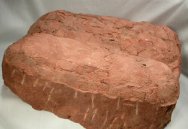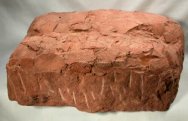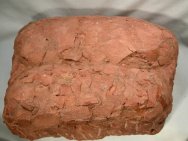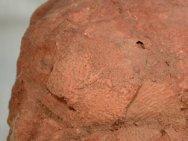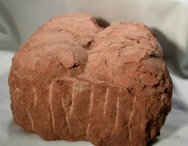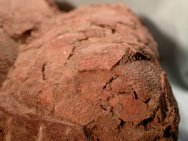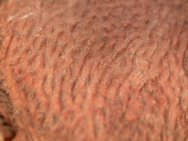|
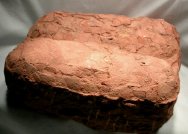 Description:
This is a fine example of a clutch (subset of nest) of dinosaur
eggs of the Oofamily Elongatolihidae. They are larger than the eggs
of the Oogenus Elongatolithus, which typically are no longer than
180 mm. Because dinosaur eggs are most often found independent of
the animal that laid them, they are typically given names associated
with their eggshell structure. A few notable exceptions are the
Hadrosaur Maiasaura and the enigmatic dinosaur Oviraptor.. The latter
is a classic example of scientists jumping to conclusions. During
the Central Asiatic Expeditions led by Roy Champan Andrews in the
1920's, the first dinosaur eggs were discovered. Due to the fact
that the most prevalent dinosaur in the region was Protoceratops,
the scientists thought the eggs were from this taxon. They found
a small unusual dinosaur in association with a nest, and assumed
that this dinosaur was overcome in the act of stealing the eggs.
They gave this dinosaur the name Oviraptor philoceratops (Ceratops-loving
egg thief). During the 1990's, several expeditions to Mongolia discovered
more examples of this association, and the scientists came to the
conclusion that the Oviraptor was BROODING the eggs - not a thief,
but a devoted parent. It is this type of dinosaur, a member of the
Oviraptoridae, that laid this egg. China has extensive Mesozoic
continental deposits called "red beds" because of their
color. It is in these beds that the eggs occur, from Shandong Province
in the east to Xinyang Ugur in the west. The eggs are found with
greatest frequency in Shandong, Henan, and Guangdong Provinces.
The mineral component of eggshell is Calcite, which can be seen
here in several areas of these well-preserved eggs. It is believed
that these eggshells were laid down through sequential formation
of the membrane and calcareous layers much as in birds. Description:
This is a fine example of a clutch (subset of nest) of dinosaur
eggs of the Oofamily Elongatolihidae. They are larger than the eggs
of the Oogenus Elongatolithus, which typically are no longer than
180 mm. Because dinosaur eggs are most often found independent of
the animal that laid them, they are typically given names associated
with their eggshell structure. A few notable exceptions are the
Hadrosaur Maiasaura and the enigmatic dinosaur Oviraptor.. The latter
is a classic example of scientists jumping to conclusions. During
the Central Asiatic Expeditions led by Roy Champan Andrews in the
1920's, the first dinosaur eggs were discovered. Due to the fact
that the most prevalent dinosaur in the region was Protoceratops,
the scientists thought the eggs were from this taxon. They found
a small unusual dinosaur in association with a nest, and assumed
that this dinosaur was overcome in the act of stealing the eggs.
They gave this dinosaur the name Oviraptor philoceratops (Ceratops-loving
egg thief). During the 1990's, several expeditions to Mongolia discovered
more examples of this association, and the scientists came to the
conclusion that the Oviraptor was BROODING the eggs - not a thief,
but a devoted parent. It is this type of dinosaur, a member of the
Oviraptoridae, that laid this egg. China has extensive Mesozoic
continental deposits called "red beds" because of their
color. It is in these beds that the eggs occur, from Shandong Province
in the east to Xinyang Ugur in the west. The eggs are found with
greatest frequency in Shandong, Henan, and Guangdong Provinces.
The mineral component of eggshell is Calcite, which can be seen
here in several areas of these well-preserved eggs. It is believed
that these eggshells were laid down through sequential formation
of the membrane and calcareous layers much as in birds.
This
is a fine 3-D example of a pair of eggs that would have comprised
a nest of some 20 or more eggs laid in a circular pattern, two or
three eggs deep, perched upon a pedestal of the redbeds from which
they were collected.
|

